Since a friend and I just did our first triathlon recently, we were thinking about what a creature optimized for a triathlon might look like, and how we could go about creating one that was loosely biologically plausible through speculative evolution. In this post I’ll show you my thought process and what I ended up coming up with!
The Rules
The goal here is to create a creature that makes sense based on earth biology as we understand it, and is significantly better at doing triathlons, both Olympic (1.5 kilometer swim, 40 kilometer bike, 10 kilometer run) and Ironman (2.4 mile swim, 112 mile bike, 26.2 mile run), than a regular human. It needs to be able to use an existing bicycle–no redesigning bicycles around its strange body geometry. Ideally it should look like it could have realistically evolved; in other words, it should probably be based on a real-world living or fossil organism or family of organisms, with traits that look advantageous for survival and reproduction.
Version 0: Velopelta triathlus
I started with the idea that humans are already pretty good at cycling and running, but could use a lot of help on the swim. This creature runs and cycles like a human but swims backwards, using its tail for propulsion and tucking its legs away. It has dorsal plates shaped like a hydrofoil that allow it to reduce drag in the water. Since the only animal with extreme dorsal plates like this are stegosaurs, the creature is a highly derived stegosaur.
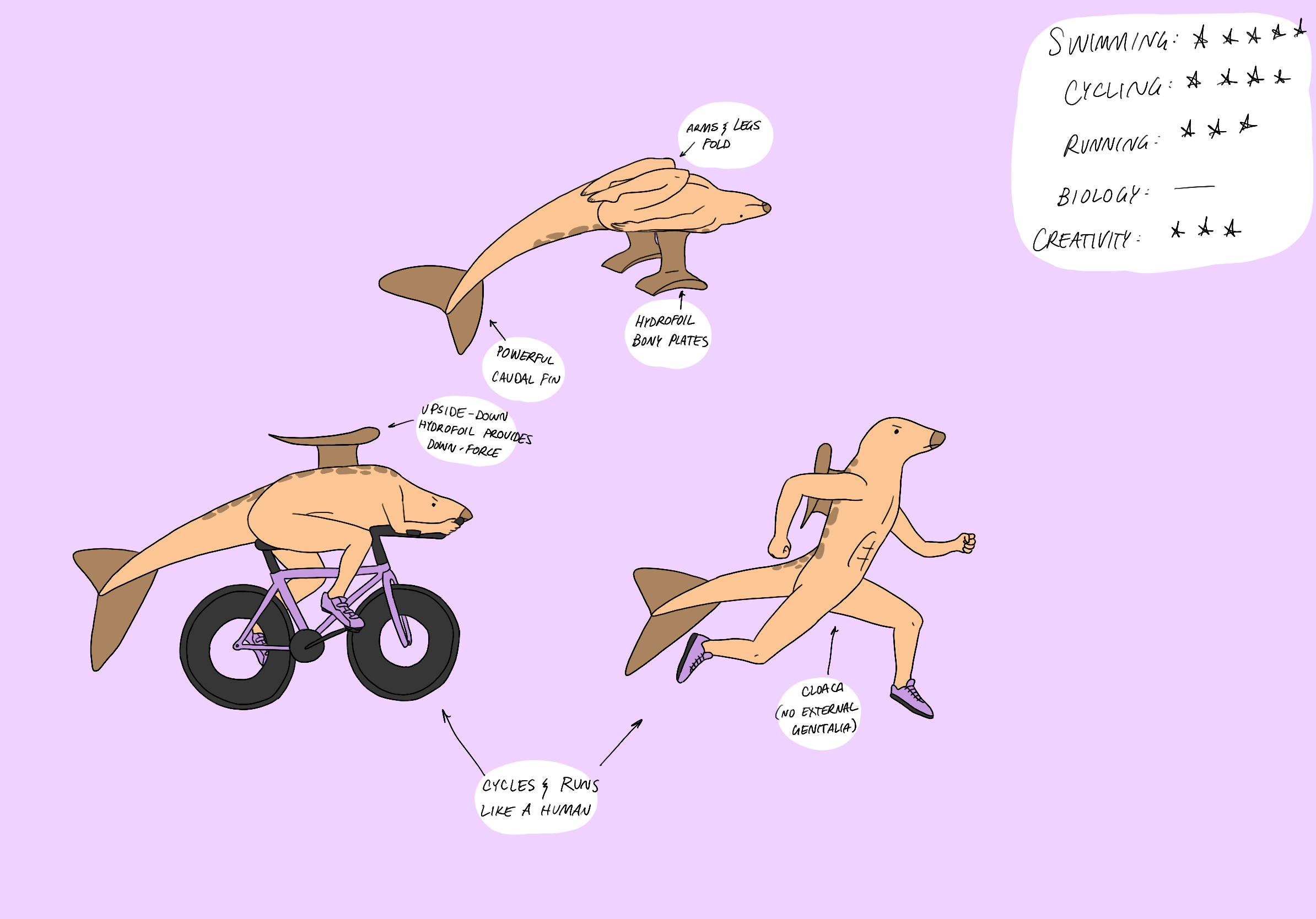
This design has many flaws:
- A hydrofoil is a highly specialized structure with no precedent in real organisms
- Even if an organism could produce a natural hydrofoil, it doesn’t seem evolutionarily advantageous; while hydrofoiling, the animal can’t eat, mate, etc, and swimming without hydrofoiling would be cumbersome
- A stegosaur evolving humanlike upright bipedality is highly improbable
Edit: I have now heard of a hydrofoil in nature! The Late Devonian freshwater placoderm, Groenlandaspis, was a fish whose armor formed a hydrofoil that would’ve allowed it to swim efficiently (but it’s unlikely that it would’ve used it to rise out of the water).
So, I addressed most of these and moved on to Version 1, which I posted to Reddit in both r/triathlon and r/SpeculativeEvolution.
Version 1: Velocetus triathlus
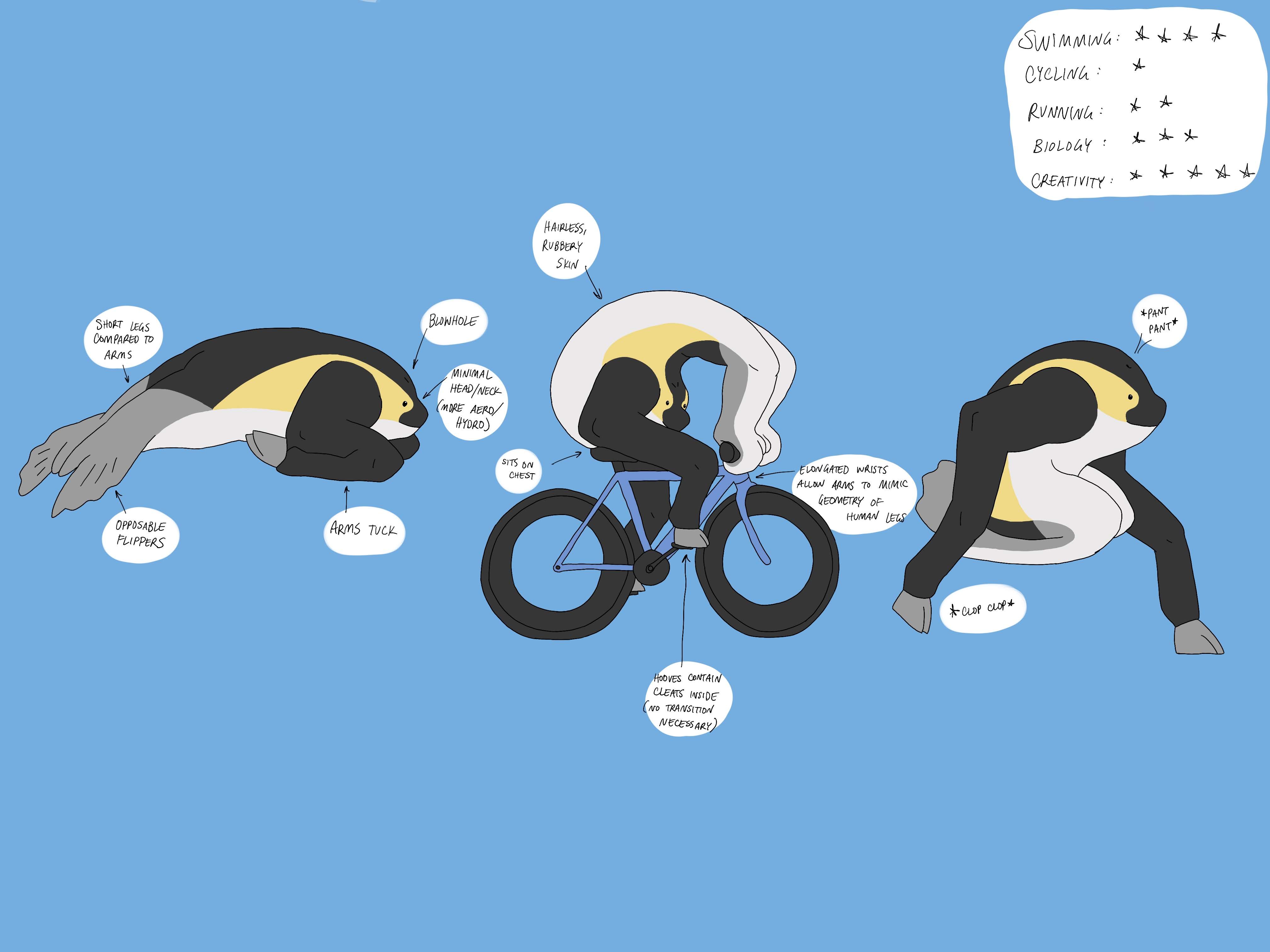
With this creature, I flipped it over relative to Velopelta but kept the idea that it would swim in one configuration and then run/cycle completely differently: Velocetus swims with its legs, then flips over and does the rest with its arms. It doesn’t need to change clothes or anything to transition between any of the events–its blubber acts as a natural wetsuit, and it installs toe clips into its hooves like a horseshoe prior to the race. “Velocetus” means “swift whale”–I imagined this creature evolving from a hoofed whale ancestor like Indohyus, but taking a completely different strategy to a semi-aquatic lifestyle, using its hind legs for propulsion like a pinniped rather than its tail, and keeping its hooves for effective terrestrial locomotion.
I got a lot of good feedback on Reddit about the flaws of this design:
- It looks the opposite of aerodynamic on the bicycle
- The blowhole is compressed while on the bicycle–looks hard to breathe
- It looks very massive–maybe blubber isn’t the best idea
- It can’t pump its legs while running–they are just dead weight, and holding them up off the ground looks tiring on the core
This brings us to Version 2, in an attempt to address some of these problems.
Version 2: Velosaurus triathlus
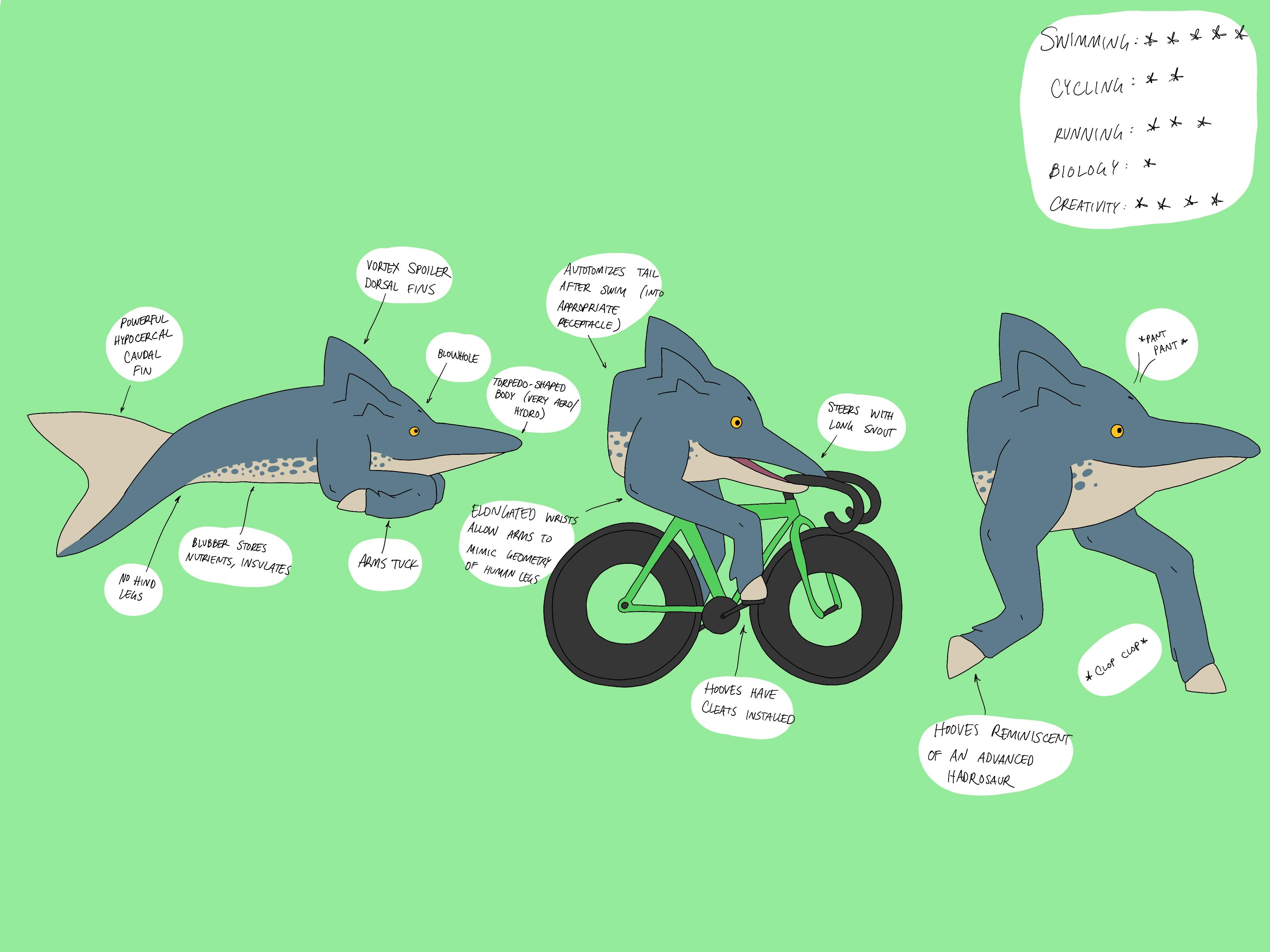
Someone on r/SpeculativeEvolution suggested autotomy (dropping its tail like a lizard) as a transition strategy, which Velocetus is unable to do for two reasons: it’s a mammal, and also it uses its hind legs to swim rather than a tail. So, this creature uses its tail to swim and then ditches it into an appropriate receptacle in the transition area before getting on the bike. It also has no hind legs at all, using its snout to steer the bike instead. It has hooves reminiscent of advanced hadrosaurs–a new mummified specimen of Edmontosaurus that hasn’t been formally described yet, known only as “Dakota,” shows that hadrosaurs may have had keratinized hooves. This is important because prior to this the most hoof-like foot previously known within Reptilia belonged to Boverisuchus, and those were multiple small hoof-like nails that didn’t look like they could support a horseshoe. It also has multiple dorsal fins that act as vortex spoilers. By this strategy, it solves a lot of the problems that Velocetus had–Velosaurus doesn’t have to contort itself, looks way more aerodynamic, and isn’t hauling around any extra weight–but it comes with its own flaws as well:
- It can’t really shift gears or brake on the bike, unless it has some sort of long prehensile tongue like a giraffe, which doesn’t have precedent among reptiles (as far as I know).
- It can’t eat or drink at all during the race unless someone feeds it, especially on the bike, since it has no opposable appendages.
- It can only race once per however long it takes the tail to grow back completely. An anole takes two months to regrow a tail and has a lifespan of six years; scaling that up linearly to a humanlike 80 year lifespan, it would take Velosaurus two years to regrow the tail. Since it can’t train while the tail is regrowing, it could probably realistically only race once per 2.5 to 3 years.
- It may be too much of a chimaera–all of its constituent features come from within Reptilia, but the tail-dropping is a lepidosaur thing while the hooves are an archosaur thing. I think Velosaurus is probably a lepidosaur that convergently evolved hooves, but I’m not sure if that’s plausible enough.
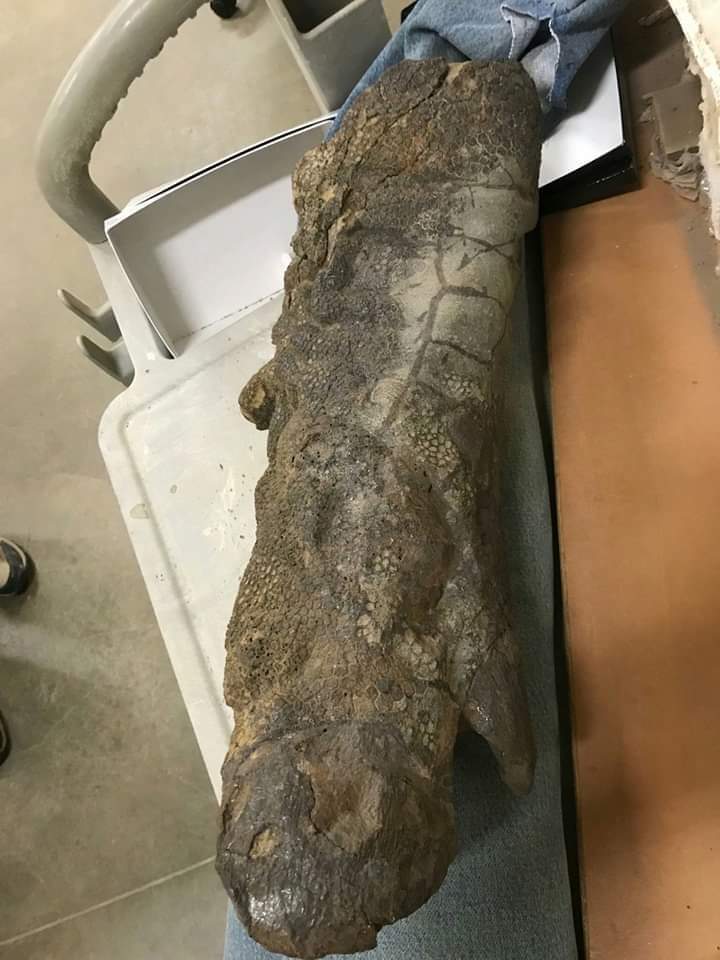
Above: A mummified Edmontosaurus forefoot. What a beautiful specimen!!
Other suggestions include having a snakelike two-part lower jaw that can slot into a bike’s aero bars, that hooves are too unstable for a biped, and that running on four limbs is faster.
Version 3: Velosuchus triathlus
By now, I feel like I’ve strayed maybe a bit too far from the original goal, and have been over-optimizing on eliminating transitions and improving the swim at the cost of actually being a good runner and cyclist. Given the constraint that the bike has to be a regular human’s bike, maybe something more human-shaped would do better riding it. And maybe doing the run on four legs would actually be better, like a sled dog, which can run 10-15 mph almost indefinitely (the world-record Ironman pace, set by Marino Vanhoenacker in 2011, was a 9.9 mph pace), as long as the creature also has the sled dog’s non-reliance on carbs for fuel. Imagining something somewhat human-shaped but quadrupedal made me think of Hallopus, a Mesozoic cursorial crocodylomorph. Thus, Velosuchus was born.
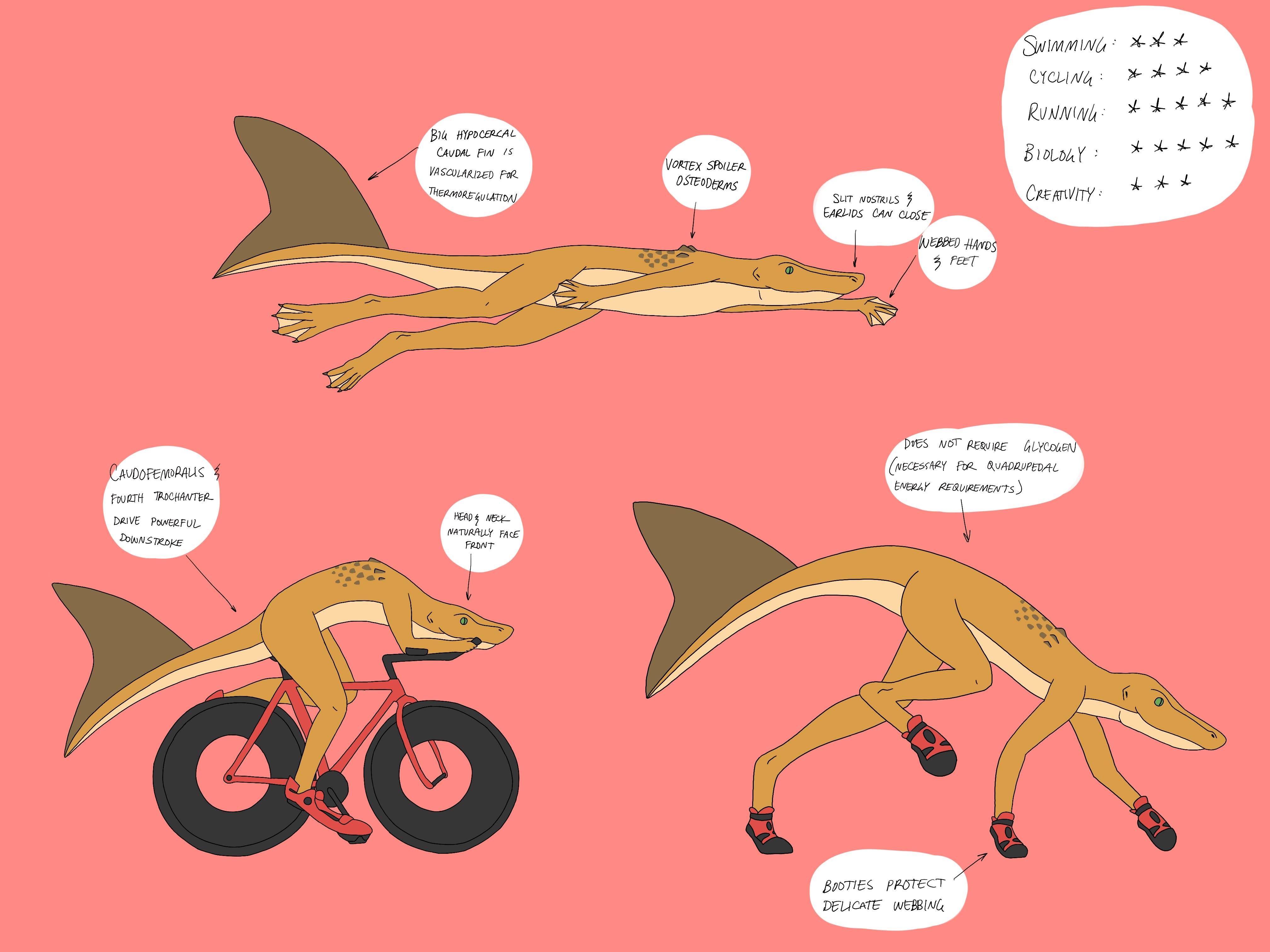
It’s basically just a scaled-up Hallopus with webbed feet, a shorter, more powerful tail, and a tail fluke. Not nearly as whimsical or freakish as Velocetus and Velosaurus, but looks significantly more effective. It probably wouldn’t be nearly as good at the swim, but the swim is the shortest portion of the race; being a good cyclist and a good runner matter much more in terms of overall time.
His main improvements over the other designs are:
- As an archosaur, he has a caudofemoralis muscle and a fourth trochanter. That is, his big, bulky, stiff tail helps improve his hind-leg power by attaching directly to his thighbone. This is an ancestral archosaurian trait, and should significantly improve his running and cycling performance.
- Some people, seeing a pseudosuchian, thought he must be cold-blooded. He isn’t! There’s no way an ectothermic creature would be a good racer. Thankfully, endothermy is also the archosaurian ancestral condition, so Velosuchus has the right to be warm-blooded if I say he is.
- Since he can’t sweat, his caudal fin needs to be highly vascularized, like an elephant’s ear, to help him keep cool during the bike and run portions.
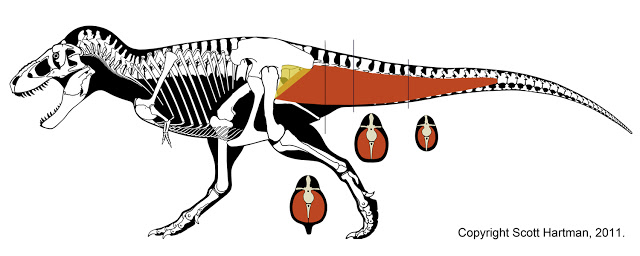
Above: Tyrannosaurus rex’s caudofemoralis (tail) muscle. It connects to the fourth trochanter, a bone protrusion on the femur, to help pull the leg backward.
Some drawbacks Velosuchus has compared to the other two include:
- Needs to actually transition (might need a wetsuit, needs to don and doff bike shoes and running booties)
- Carries its tail around for the rest of the race (although this is mitigated by the caudofemoralis aiding its leg power)
- No blubber (needs to keep eating throughout the race)
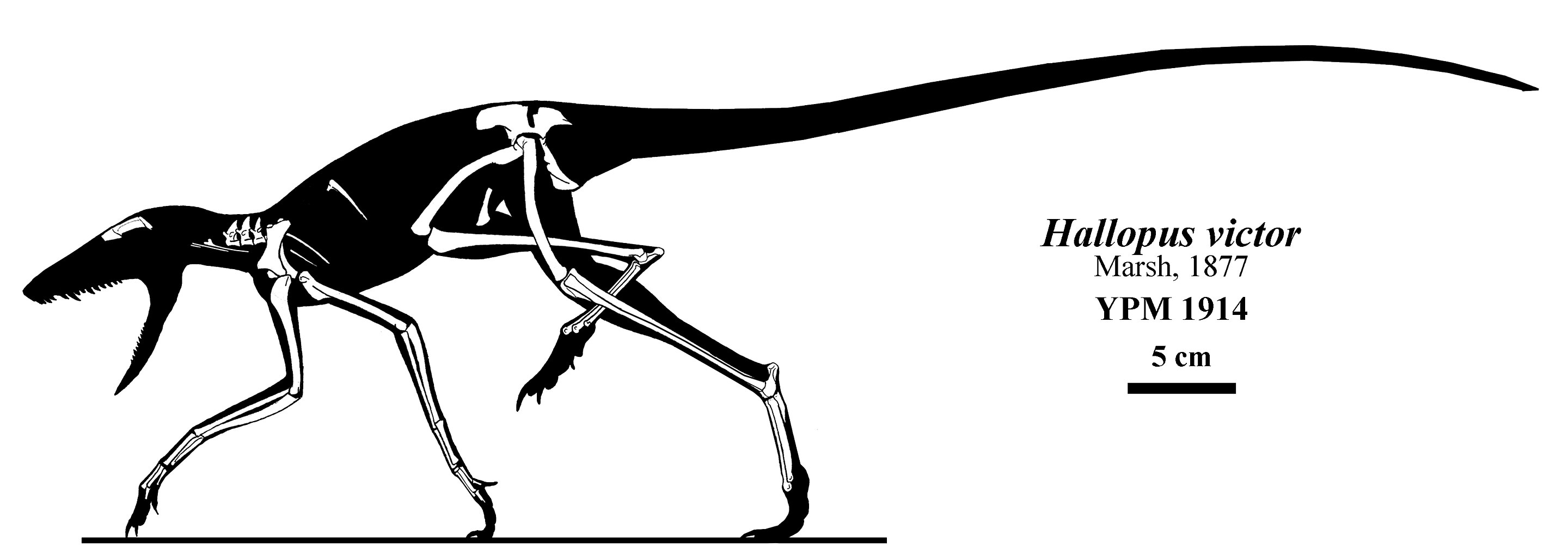
Above: Hallopus skeletal. “Hallopus victor” means “leaping foot winner”! Now that’s what I want in a triathlete.
But I think in a race between these three, Velosuchus would probably win. It’d start out behind after the swim, since the other two are very powerful swimmers, but quickly pass Velocetus on the ride (cycling is Velocetus’s weakest event) and scamper past the clunky Velosaurus on the run. Now let’s rigorously map out the race and see what actually happens!
Estimated times for an Ironman:
| Event | Velocetus | Velosaurus | Velosuchus | Marino Vanhoenacker | Average Iron Human |
|---|---|---|---|---|---|
| 2.4 mi swim | 0:08:00 | 0:03:36 | 0:15:27 | 0:46:49 | 1:16:00 |
| T1 | 0:00:02 | 0:01:00 | 0:03:00 | 0:02:04 | 0:03:00 |
| 112 mi bike | 9:20:00 | 7:28:00 | 5:36:00 | 4:15:37 | 6:25:00 |
| T2 | 0:00:02 | 0:00:02 | 0:04:00 | 0:02:04 | 0:03:00 |
| 26.2 mi run | 6:33:00 | 5:14:24 | 1:44:48 | 2:39:24 | 4:54:00 |
| TOTAL | 16:01:04 | 12:46:04 | 7:43:15 | 7:45:58 | 12:41:00 |
Assumptions:
- Velocetus swims at 18 mph (like a seal), bikes at 12 mph (pretty bad), and runs at 4 mph (15-minute mile pace).
- Velosaurus swims at 40 mph (marlins swim at 50 mph, but at those speeds the drag from the tucked arms would slow it down significantly), bikes at 15 mph (not great), and runs at 5 mph (12-minute mile pace).
- Velosuchus swims at 9.32 mph (like a crocodile), bikes at 20 mph, and runs at 15 mph (like a sled dog, 4 minute mile pace).
- Marino Vanhoenacker swims at 3.08 mph, bikes at 26.3 mph, and runs at 9.86 mph (6:05 mile pace).
- An average human Ironman finisher swims at 1.89 mph, bikes at 17.5 mph, and runs at 5.35 mph (11:13 mile pace).
Ironman Race Commentary
They’re off, Velosaurus quickly taking the lead, man he’s fast in the water. He’s out of the water in a superhuman three minutes, taking a minute in T1 to drop his tail in an appropriate receptacle, and he’s already on the bike before anyone else has finished the swim. Velosaurus has gotten a 0.86 mile head start on the bike by the time Velocetus gets out of the water; Velocetus hops onto the bike upside-down, wow, check out the acrobatics over here, and he’s off, tailing Velosaurus, but it doesn’t look like he’s gonna catch him, Velosaurus is just a bit faster on the bike, maybe because he’s not, y’know, upside-down. Seven minutes later, Velosuchus emerges from the water, he takes a couple minutes to dry his feet and put on his bike shoes before he’s off as well, chasing the other two. He looks a lot better on the bike though, shouldn’t take him too long to catch up. Right now Velocetus is 2.08 miles down the road, Velosaurus at 3.46 miles. They’ve still got a ton of race to go!
It’s now been 34 minutes and 3 seconds, we’re still waiting for the humans to finish the swim, and Velosuchus is passing Velocetus on the bike at mile 5.2! Whew, he really flew by. Velosaurus is still ahead, currently at mile 7.36, but his lead is steadily shrinking…
Finally, Marino’s done with his swim, at 46 minutes and 49 seconds! He takes two minutes to transition and then he’s off on the bike, chasing the three freaks of nature, Velocetus, Velosuchus, and Velosaurus, who are currently 8.17, 10.14, and 11.07 miles ahead of him, respectively.
The elapsed time is now 57:56, and Velosuchus has caught Velosaurus on the bike, at mile 13.16! It’s over for Velosaurus, folks, there’s no way he’s gonna catch up to Velosuchus now. Velocetus is still chugging along at mile 9.98, and Marino’s at mile 3.97 and gaining.
Eighteen minutes later, our Average Iron Human representative is out of the water, taking a couple minutes to transition and chasing the rest on the bike. The elapsed time is now 1:19:00.
Marino is overtaking Velocetus on the bike at mile 15.02! The elapsed time is now 1:23:10. Velosaurus is still biking at mile 19.64, and Velosuchus is at mile 21.57. Average Iron Human is trailing at mile 1.22.
Marino is now overtaking Velosaurus on the bike at mile 25.77! The elapsed time is now 1:47:42. Average Iron Human is still trailing at mile 8.37, Velocetus is at mile 19.93, and Velosuchus is at mile 29.75.
Oh man, Marino is passing Velosuchus on the bike at mile 42.38! Marino is now in the lead! Can Velosuchus make up the time on the run?? The elapsed time is now 2:25:36. Average Iron Human is still trailing at mile 19.42, Velocetus is next at mile 27.51, and Velosaurus is at mile 35.25.
Average Iron Human is overtaking Velocetus at mile 45.15! The elapsed time is now 3:53:49, Velosaurus has ridden 57.3 miles, Velosuchus has ridden 71.79 miles, and Marino has ridden 81.05 miles.
And Marino has finished the ride, changed shoes, and taken off running! The elapsed time is now 5:06:34 and everyone else is still biking.
Fifty minutes later, Velosuchus has finished the ride, taken off his shoes, and is chasing Marino on all fours! Will he catch him?? The elapsed time is now 5:57:27 and everyone else is still biking. Marino is 8.36 miles down the road, but man is Velosuchus a fast runner! This is gonna be so close!
Velosaurus finally finished the bike portion, hopped off, and started down the marathon course, still ahead of Average Iron Human, but barely! The elapsed time is now 7:32:38, and Velosuchus and Marino are closing in on both each other and the finish line!
The elapsed time is now 7:35:02, and Velosuchus has sprinted past Marino, with only 1.81 miles remaining in the race! Oh, the look on Marino’s face–! Oh well, maybe next time, mere human!
And Velosuchus sets the new world record for fastest Ironman with a final time of 7 hours, 43 minutes, and 15 seconds! (As well as a world-record marathon time of 1:44:48!) Marino Vanhoenacker comes in a very close second, 6 minutes and 15 seconds later, with a total time of 7 hours, 45 minutes, and 58 seconds. Average Iron Human is almost done biking, and Velocetus has been totally left in the dust, he’s still on mile 91.6 of the bike portion, with over twenty miles remaining to cycle! Velosaurus is plodding along at mile 1.1. Don’t give up, Velosaurus! You can do it!
One minute later, Average Iron Human has finished the bike and started the run, elapsed time 7:47:00! Will he be able to catch Velosaurus? It’s a race for third now, and it’s gonna be a close one!
We’ve come back from our two-hour lunch break to witness Velocetus finally finishing the bike and starting the run. The elapsed time is now 10:01:02. Velosaurus is on mile 12.4 and Average Iron Human is slowly but steadily gaining and is currently on mile 12.0!
Whoa! Average Iron Human has finally pulled ahead of Velosaurus on mile 18.3, with just 7.9 miles left in the race! Okay, I guess it wasn’t that close. But Velosaurus put up a pretty decent fight.
And the final results: Average Iron Human crosses the line at 12:41:00, Velosaurus only 5 minutes behind at 12:46:04, and Velocetus comes in fifth with a final time of 16:01:04! Good job finishing, Velocetus. Participation medal for you.
Conclusions
After doing the actual back-of-the-envelope math, I ended up finding that the cycling portion, being the longest by far, is way more important than I was treating it conceptually, and even though Velosaurus and Velocetus are able to complete the swim 40 minutes ahead of the best human, they quickly blow their lead since they’re not so great at cycling. (This is a lesson real-life triathletes learn as well–it’s better to be a cyclist who happens to run and swim than a swimmer trying to cycle and run).
Another thing to note is that the three competing creatures are supposed to represent “average Ironman” versions of their respective species. That is, their true goal was to beat the Average Iron Human, and the fact that the Average Iron Velosuchus was able to beat Marino Vanhoenacker is really just a bonus. It means that I succeeded in designing a creature that is categorically better at triathlons than humans, and perhaps an exceptional specimen of Velosuchus would totally blow Marino’s record out of the water. It also means that my first two attempts were abysmal failures, since they didn’t even beat the Average Iron Human–they’re categorically worse at triathlons! I achieved the opposite of what I was trying to do, with those two.
I’m sure that some people will disagree with some of my assumptions, especially on the cycling and running portions for Velocetus and Velosaurus. It’s sort of hard to tell how fast a creature with no real-world analog would really be able to move. It’s also hard to tell how fast Velosuchus would be able to bike–he would be helped by his naturally low head posture and his spoiler osteoderms, but impeded by having to carry the weight and deal with the drag of the tail (although this is mitigated by the caudofemoralis). He may also be helped by being so skinny and having such long legs, but it’s hard to tell how much that would matter. I kind of ended up picking 20 mph out of thin air, just deciding that “that feels about right” and seeing how the race came out organically.
One more interesting thing to note is that the best cyclist by far is still the human, Marino Vanhoenacker. I guess that makes sense–since bikes were designed specifically for humans to use, humans are already the most efficient users of these bikes. Maybe in the future I’ll do a race where the nonhuman competitors are allowed to bring their own bikes…
It’s also a little disappointing that the best creature design was sort of just a human in an alligator suit. I was hoping that by doing something radically different, I could give the creature a leg up, but I guess this makes sense too–since the race is designed by humans for humans, and humans don’t like swimming very much, the swim is by far the shortest leg of the race. If the race were designed by Velocetus for Velocetus, the swim would be the longest and the bike would be the shortest.
Updates
I’ve incorporated the digitally remastered versions of the drawings into the main post now, and put the original ink drawings below.
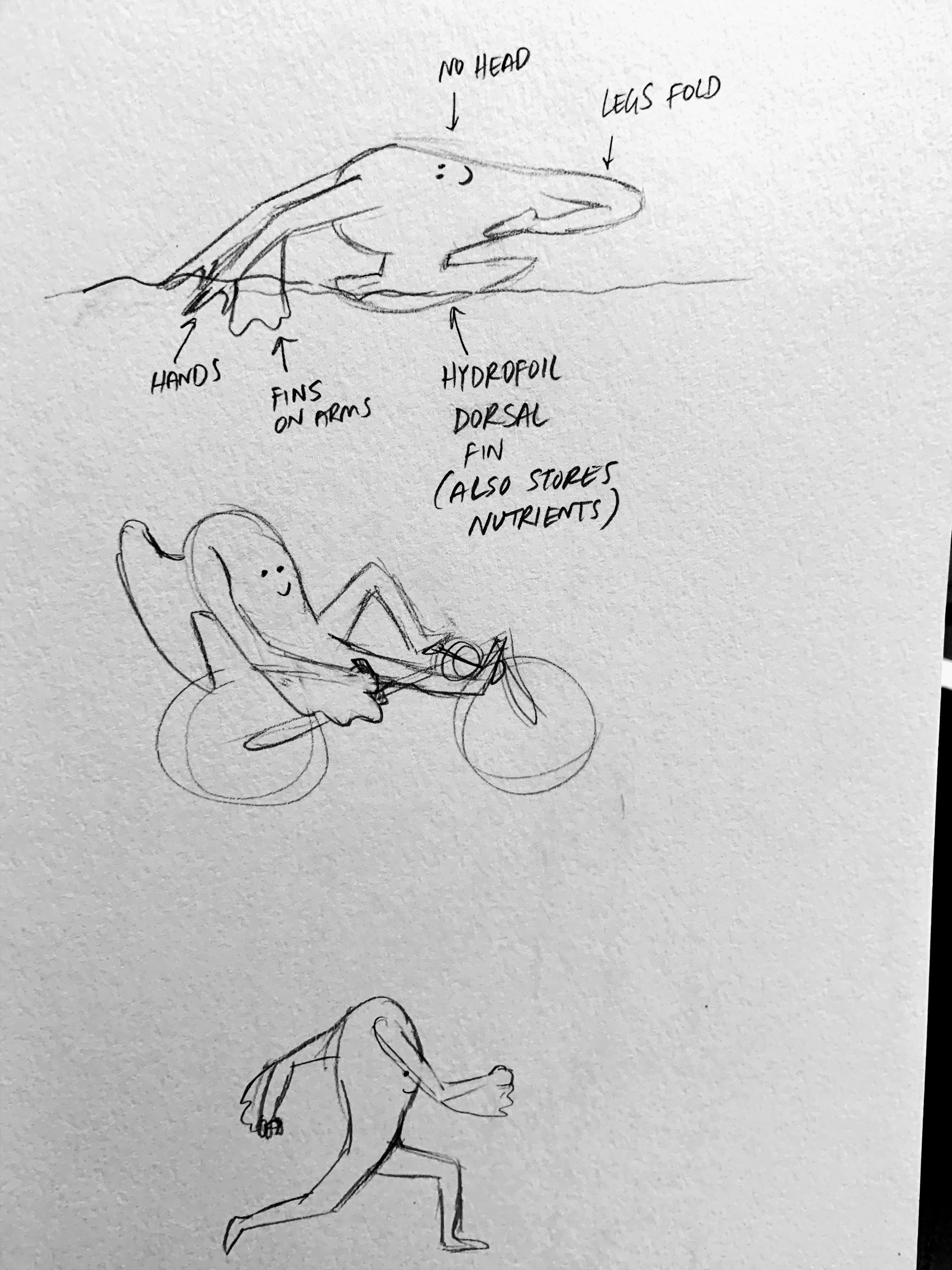
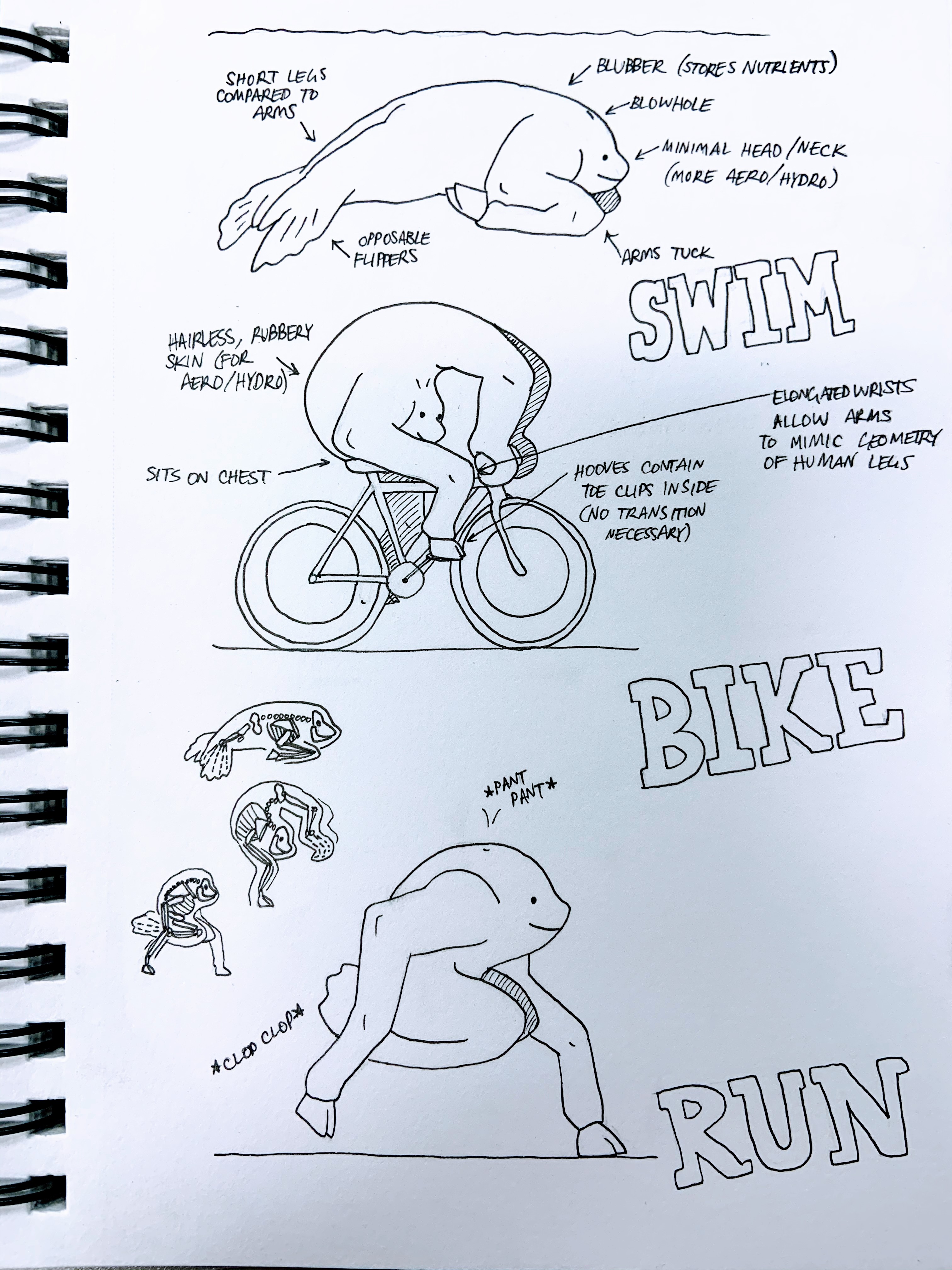
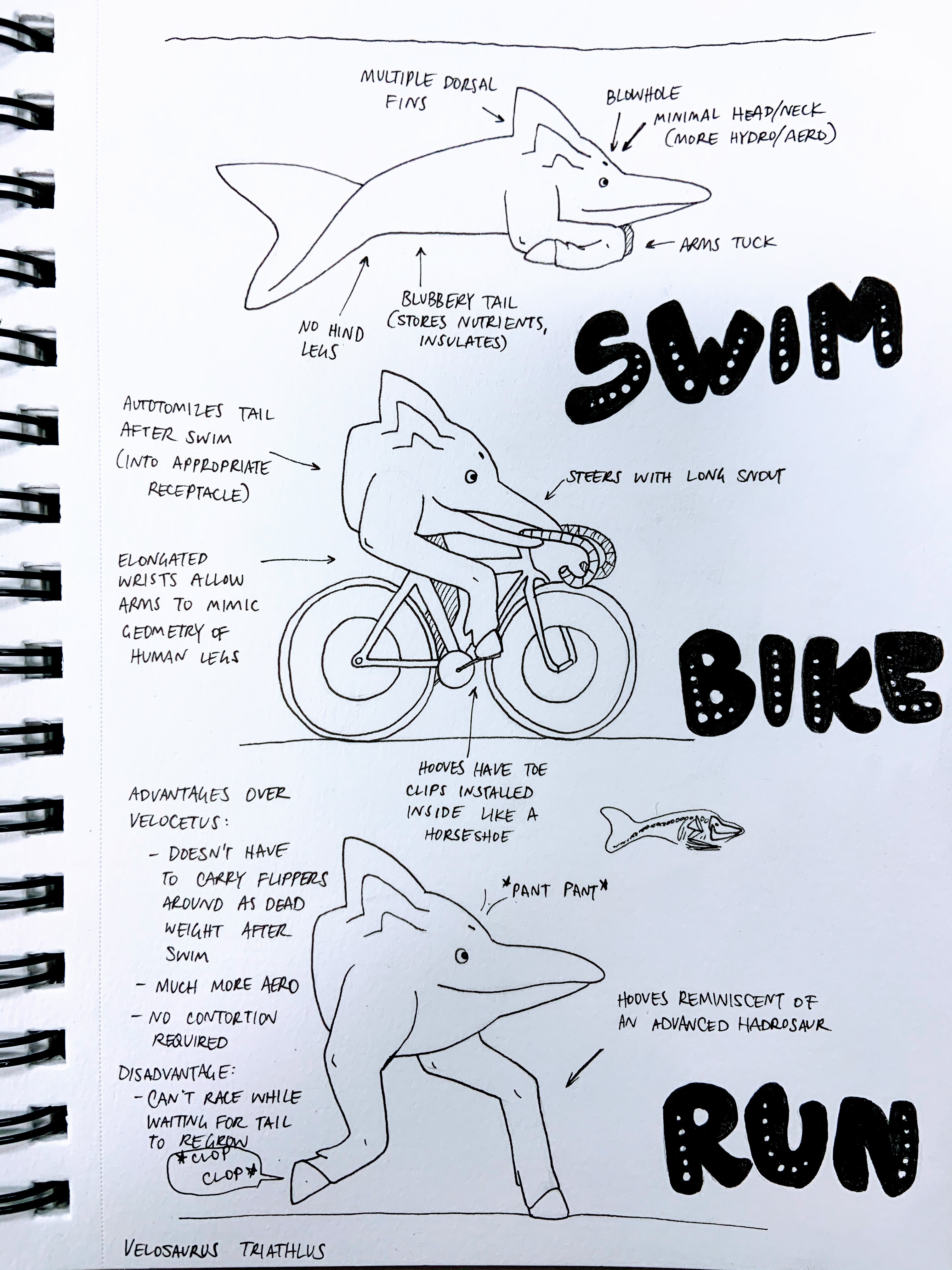
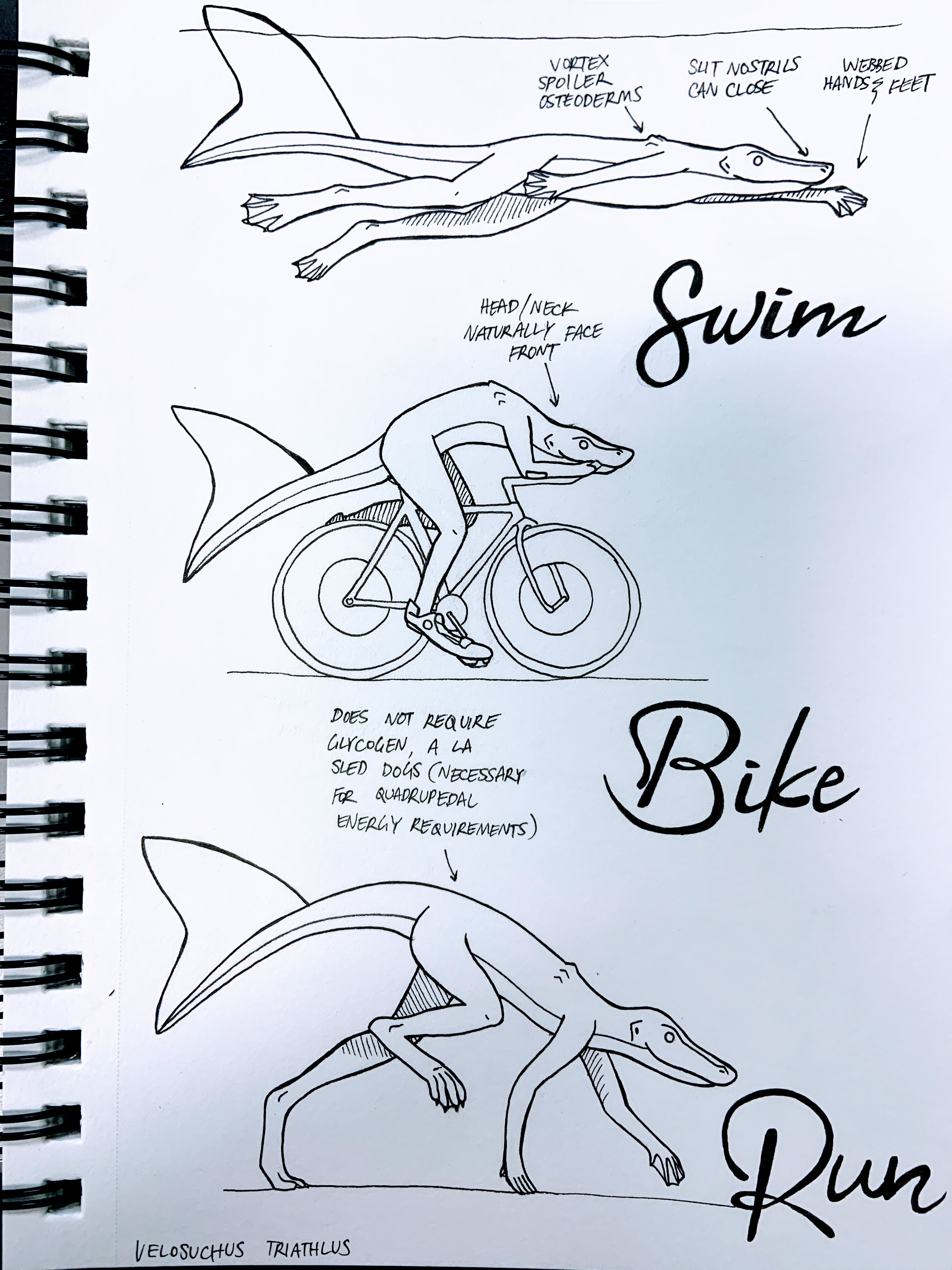
Image credits: Edmontosaurus hoof Hallopus skeletal Tyrannosaurus caudofemoralis
